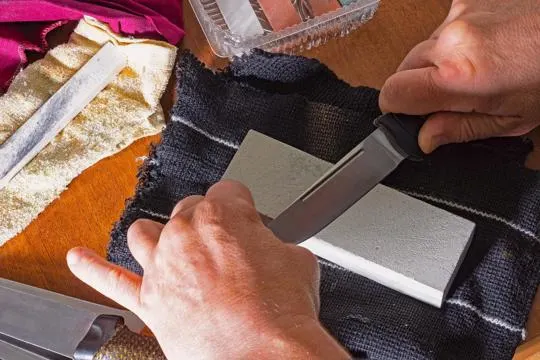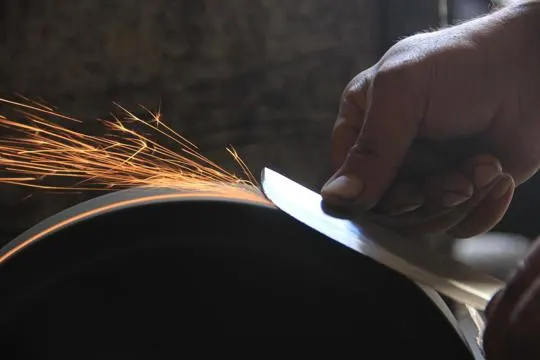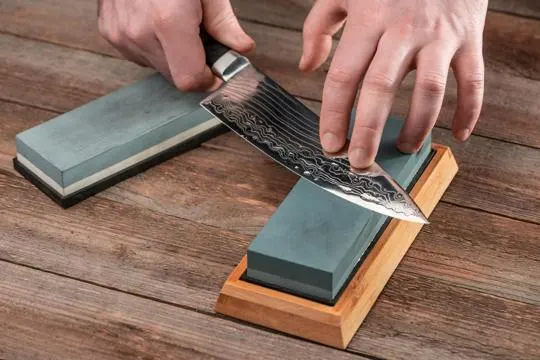Summary of key points
The main difference between a knife sharpener and whetstone is in the method of sharpening. A knife sharpener uses mechanical abrasives to sharpen a blade, while a whetstone requires manual rubbing of the blade against the stone.
In terms of convenience, a knife sharpener is faster and easier to use, but may not provide as precise results as using a whetstone. Whetstones, on the other hand, require more skill and practice to achieve a sharp edge.
In terms of versatility, a knife sharpener can usually be used for various types of knives, while whetstones may be specific to certain blade types or sizes.
In the kitchen battleground, two champions stand ready. Knife sharpeners and whetstones.
Each holds the key to razor-sharp blades.
We’ve all been there. Slicing tomatoes turns into a squish fest. That’s our cue. Time for some blade TLC.
Knife sharpeners offer quick fixes. A few swipes, and you’re back in action.
Whetstones require patience and skill. Like meditation for your knife.
We’ve tried both. Laughed at our mishaps. Cheers to perfectly sliced onions and our fingertips intact.
Choosing your ally in the kitchen isn’t trivial. It’s about precision, care, and a bit of flair.
Understanding Knife Sharpeners

Knife sharpeners are must-haves for keeping knives sharp.
Different varieties exist, each with their own features and benefits.
Pros and home cooks alike should know the types to pick the right one.
Electric sharpeners are popular, as they’re convenient and easy to use.
With a motor, they grind down the blade quickly.
But, some electric sharpeners can remove too much metal, shortening its life.
Manual sharpeners take more effort and skill.
Usually, they contain two pieces: a rough-grit side and a fine-grit side.
This requires practice, but it gives more control over the sharpening process.
Whetstones are a classic choice for knife lovers.
Natural or synthetic, they need water soaking before using.
The coarse side repairs chips and reshapes the blade, while the fine side removes burrs and refines the edge.
This hands-on approach results in a better sharpness.
Whetstones have more control over how much metal is removed.
Plus, they offer the ability to adjust the angle for different levels of sharpness.
Understanding Whetstones

Whetstones, also known as sharpening stones, are key tools for keeping knives sharp.
Different grits serve various purposes: coarse grits remove metal and fine grits polish the edge.
Water or oil lubricates the blade during sharpening.
Whetstones can be used on kitchen blades, hunting and pocket knives.
Consistency in angle is vital for an even and precise edge.
Let’s explore their unique characteristics.
Whetstones can be natural stones like Novaculite or synthetic abrasives like aluminum oxide or silicon carbide.
Natural stones are durable; synthetic stones provide consistency and versatility.
Grit size varies. Coarse stones repair damaged edges or reshape blades.
Finer stones refine the blade’s edge and sharpen it.
Choose the right grit sequence for your knife’s condition and preference.
Whetstones come in different shapes and sizes.
Larger bench stones are stationary.
Compact handheld versions are portable.
Pick the shape and size that suit your needs and convenience.
Clean your whetstone thoroughly after each use.
Rinse off debris or metal shavings. Allow it to air dry before storing it.
Differences Between Knife Sharpeners and Whetstones

Knife sharpeners and whetstones are distinct tools for sharpening knives.
They differ in their method, performance, and convenience.
Knife sharpeners use abrasives or grinding wheels to quickly restore sharpness.
Whetstones are natural or synthetic stones requiring manual effort and skill.
Knife sharpeners offer quick results but may be less precise.
If not used properly, they can shorten blade lifespan.
Whetstones allow for greater control and precision, allowing for razor-sharp edges and preserving more of the blade’s original material.
Portability is another difference.
Knife sharpeners are compact and lightweight, making them convenient to use.
Whetstones are bulkier and require water or honing oil for lubrication, but offer various grit options.
Cost plays a role too.
Entry-level knife sharpeners can be affordable, but high-quality electric ones or specialized models can be expensive.
Whetstones usually have one-time cost with no additional maintenance.
To make an informed decision, consider portability, cost, and other factors.
This will help maintain knife sharpness.
Mechanism and Function
A knife sharpener and a whetstone differ in function and mechanism.
A knife sharpener often uses abrasive materials or power to give a blade its sharpness back quickly and effectively.
In contrast, a whetstone needs manual labour.
Rubbing the blade against the stone’s surface at a specific angle is what you need to do.
This might take more time but gives you better control and more exact results.
Both professional chefs and home cooks can choose the method that suits them best for knife maintenance.
Sharpening Process
Sharpening is the process of making a dull cutting tool or blade into a sharp one.
It’s essential for keeping the quality and durability of any cutting instrument.
To sharpen, people can use a knife sharpener or a whetstone.
Both tools sharpen blades but in different ways.
Knife sharpeners are popular because they are easy to use.
They reshape dull blades by removing metal and making a sharper edge.
Knife sharpeners feature preset angles and abrasives, which makes sharpening easier and more accurate.
But some knives can’t be sharpened with this method.
Whetstones have been used for centuries for sharpening.
This method requires skill and technique.
Whetstones are flat stones with various levels of coarseness.
By sliding the blade across the stone while applying pressure, the user grinds away the dull edges.
It may take more time to get the hang of it, but it gives more control over the sharpening process and works with different blade types.
Versatility and Flexibility
Versatility and flexibility are key when choosing between a knife sharpener and a whetstone.
Each has advantages, and each is unique.
Knife sharpeners offer convenience and efficiency.
They often come with settings or angles to fit various knife types and sizes.
Serrated, pocket, or kitchen knives can all be sharpened quickly and easily.
Whetstones provide control and precision.
Abrasive materials like aluminum oxide or ceramic are used.
Manual effort is needed to glide the blade across the surface at the desired angle.
Different grit levels are available for coarse or fine sharpening.
This allows for customization and skill development.
Comparing the qualities of both tools is necessary to find the right one.
Knife sharpeners are great for everyday use, while whetstones are perfect for skill development and customization.
Consider your priorities to make an informed decision.
Skill and Learning Curve
Comparing knife sharpeners and whetstones requires considering skill and learning curve.
They both sharpen knives, but require different levels of skill and learning.
Using a knife sharpener needs expertise for optimal results.
It usually has an automated mechanism guiding the knife through slots.
Necessary practice includes maintaining the correct angle and pressure.
A whetstone needs manual dexterity and precision.
It involves rubbing the knife against the stone at a specific angle.
This requires steady hands and an even sharpening process.
The learning curve may be steeper than a knife sharpener, as it relies on technique and experience.
Adaptability sets these tools apart.
Knife sharpeners are designed for convenience, but lack customization of whetstones.
Whetstones allow adjusting the grit levels, offering control over the sharpening process.
In conclusion, choose between these tools based on preferences and needs.
Knife sharpeners require practice, while whetstones require proficiency.
Similarities Between Knife Sharpeners and Whetstones

Knife sharpeners and whetstones have many things in common.
Both are used to sharpen knives and make them cut better.
They can make a dull knife sharp again, and make cooking enjoyable.
Plus, both require manual work.
You must grind or hone the blade against the surface.
This way you can control how sharp it is and make sure it is just right.
Even though they look different and are made from different materials, they both do the same job of keeping your knives sharp.
Choosing the Right Option: Factors to Consider
Pick the right one: knife sharpener or whetstone? Consider these factors first:
- Knife type. Different sharpeners work better on certain blades.
- Skill level. Whetstones require more skill and practice than sharpeners, so they might be better for beginners.
- Time and effort. Sharpeners are quicker and easier to use, but whetstones take more time and patience.
- Budget. Sharpeners cost more, but whetstones are usually more affordable.
Consider these details, then decide which option is best for you.
Knife Type and Blade Material
Knife Type and Blade Material are both hugely important in determining a knife’s effectiveness and durability.
Various knife types have distinct blade materials, influencing sharpness, reliability, and overall usefulness.
When it comes to knife types, there’s a huge range to pick from.
Each type serves a particular purpose and meets diverse needs.
For instance, chef knives are good for many kitchen tasks, and boning knives are best for separating meat from bones.
Other common types include Santoku knives, serrated knives, paring knives, and utility knives.
This variety of knife types lets people choose the most suitable tool for their needs.
The blade material is also important, as it affects how well a knife keeps its edge and withstands wear and tear.
Stainless steel is popular because it doesn’t corrode and is easy to maintain.
High-carbon stainless steel is another great choice, combining sturdiness with rust resistance.
Ceramic blades are very sharp, but can chip or break if handled roughly.
Additionally, some specialized knives might have unique blade materials like Damascus steel or laminated blades with multiple metal layers for extra strength and cutting power.
To make sure you choose the right knife for a job, you need to think about both the knife type and blade material.
This way, you can get a tool that meets your needs and works properly and for a long time.
Budget and Convenience
Sharpening knives can be done with two main options – knife sharpeners and whetstones.
They vary in cost and convenience.
Knife sharpeners are more affordable and come in manual and electric forms.
They’re easy to use, even for novices, and allow blades to be sharpened quickly.
Whetstones, on the other hand, require a bigger initial investment but are a long-term solution.
They let you customize the angle and pressure to get razor-sharp edges.
Using a whetstone takes practice, but once you master it you’ll feel a great sense of accomplishment.
Sharpening Goals and Experience
When it comes to knife sharpening, your goals and experience are key.
You’ll need to choose between a knife sharpener or a whetstone.
It depends on what you want to achieve and your skill level.
If you want to restore a dull knife quickly and easily, then get a knife sharpener.
These make sharpening simple, even for beginners.
Experienced sharpeners may not get the precision and control they want.
For complete control over the outcome, choose a whetstone.
This traditional method requires practice, but it gives you more customization.
You can adjust angle, pressure and speed of each stroke, for a finely honed blade to your liking.
Think about how much involvement you want in the process, and choose accordingly.
Both options have their advantages.
It’s up to you to decide what matters most.
Care and Maintenance of Knife Sharpeners and Whetstones
To get the most out of your knife sharpener or whetstone, it’s important to take proper care of them.
Here are some top tips:
- Keep it Clean: After each use, wipe away any metal shavings or debris with a damp cloth or brush.
- Store Safely: Store away from high humidity, to prevent rusting or corrosion.
- Sharpening Angle Matters: Be mindful of the angle when sharpening. The wrong angle can damage the blade.
- Lubrication: Some may need it for smoother sharpening. Check the manufacturer’s instructions.
- Periodic Reconditioning: Over time, they may need to be reconditioned or replaced.
Handle them with care and don’t drop them.
Regular maintenance will keep your knives razor-sharp and ready for all your cooking needs.
With proper care, you can maximize the performance and longevity of your knife sharpener or whetstone.
Conclusion
This comprehensive article should have helped readers understand the key differences between a knife sharpener and a whetstone.
The main takeaway relies on the owner’s level of skill, requiring one to make the best decision for their own situation.
One might look into purchasing both items, gaining quality results from either or providing an extra layer of diamond honing only accessible with a sharpening stone.
Quality knives don’t always come cheap, but investing in these sharpening tools will help ensure they last as long as possible and help provide optimal safety when cutting various types of food items.
Ultimately, the goal is to maintain a level edge on one’s tools, so research thoroughly before making any purchases.
It pays off in the end.

Leave a comment